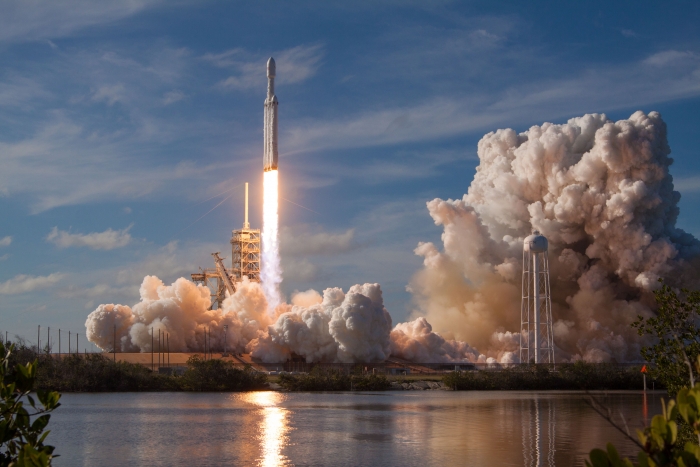February kicked off with a blast as private aerospace company SpaceX sent its most technologically advanced rocket, the Falcon Heavy, out into space on Feb. 6. This was a momentous occasion for anyone with dreams beyond our atmosphere, as the Falcon Heavy can reportedly carry a record 64 tonnes into orbit at one-third of the price of the next best vehicle. SpaceX founder and CEO Elon Musk has applied his business expertise to his most recent venture by minimizing costs, maximizing payloads, and publicizing bold marketing stunts.
The development of the Falcon Heavy is an example of entrepreneurs using the incrementalism of space travel to their advantage. SpaceX’s earlier, smaller Falcon 9 model—which has completed 47 successful launches—might not be as exciting, but its flights were crucial for testing reusable boosters.
“The concept of flying back and re-using the first stage had been around for a long, long time,” Andrew Higgins, associate professor in the Department of Mechanical Engineering, said in an interview with The McGill Tribune. “What SpaceX did that was a real game changer was to attempt it on commercial launches that were already paid for so they could learn and improve on subsequent flights, until they nailed the landing every time.”
The Falcon 9 operates by leaving enough fuel in its first stage to safely fly back to a launch platform. Business Insider estimates that about half the costs of each $62 million Falcon 9 flight can be recovered by having its components land in reusable conditions. Forbes is skeptical of how much money this technique actually saves, but supplants that with the prediction that reusable technology will be integral in Musk’s plans to colonize Mars.
“Previously, rockets had been designed from scratch to meet the specification of a mission,” Anthony Ubah, avionics lead of the McGill Rocket Team, wrote in a message to the Tribune. “What SpaceX has done is different. Rather than develop a new rocket from scratch to meet performance specifications required in heavy lift and/or higher Earth orbits, they’ve taken a flight proven rocket design, modified it, and strapped three of them together.”
Combining three Falcon 9 rockets saves the expenses incurred by having to create a new, larger spacecraft. This leaves the Falcon Heavy with a staggering 27 engines. Launches cost $90 million, with an estimated $40 million in savings per launch, according to Business Insider, thanks to reusable boosters.
“Just like we combine inexpensive, mass-produced computers to make supercomputers, SpaceX is taking the same approach with rocket engines,” Higgins said. “The Russians tried something like this with the N1, a giant rocket with 30 engines that was key to their moon program in the 1960s. The N1 blew up every time it was launched, however, and aerospace engineers became skeptical it was possible to combine that many engines together and control them, but SpaceX has shown it can be done.”
The larger payloads made possible by the 27 engines will have sizeable effects on astronomical activity. Falcon Heavy’s is most powerful rocket currently in use, until NASA’s Space Launch System program is operational with a 70-tonne payload around December 2019.
“The Falcon Heavy is comparable in payload to NASA’s Space Launch System, which has been under development to launch astronauts on deep space missions but is running far behind schedule,” Higgins said. “For the time being, Falcon Heavy will be used to launch big communication satellites into orbit 40,000 kilometres above Earth, which is the market where the big money is for now, and not astronauts.”
Despite these successes, SpaceX is not content to rest on its laurels and is already planning its next model: The Big Falcon Rocket will be designed to carry up to 150 tonnes. One of SpaceX’s primary rivals, United Launch Alliance, has unveiled plans to develop its own reusable rocket, claiming their model will reduce costs from $350 to less than $100 million per launch. Meanwhile, NASA’s outmatched Space Launch System may also find new wings, with some suggesting that it be repurposed for military applications.
Above all, the publicity surrounding this launch will revitalize the space industry. The sheer gall of launching Musk’s Tesla Roadster into space on Feb. 8, equipped with a dummy dubbed “Starman” and Ziggy Stardust on loop, is ideally representative of the extraterrestrial adventures we can look forward to.









Just wanted to note that there is zero chance SLS would be repurposed for military applications as the article speculates. The U.S. Air Force has zero interest in SLS– It’s too expensive at $1 billion per launch and at just 1 launch per year, does not fly frequently enough to fulfill USAF EELV requirements.